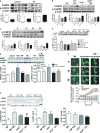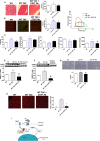Cardiac CD47 drives left ventricular heart failure through Ca2+-CaMKII-regulated induction of HDAC3
- PMID: 24922625
- PMCID: PMC4309049
- DOI: 10.1161/JAHA.113.000670
Cardiac CD47 drives left ventricular heart failure through Ca2+-CaMKII-regulated induction of HDAC3
Abstract
Background: Left ventricular heart failure (LVHF) remains progressive and fatal and is a formidable health problem because ever-larger numbers of people are diagnosed with this disease. Therapeutics, while relieving symptoms and extending life in some cases, cannot resolve this process and transplant remains the option of last resort for many. Our team has described a widely expressed cell surface receptor (CD47) that is activated by its high-affinity secreted ligand, thrombospondin 1 (TSP1), in acute injury and chronic disease; however, a role for activated CD47 in LVHF has not previously been proposed.
Methods and results: In experimental LVHF TSP1-CD47 signaling is increased concurrent with up-regulation of cardiac histone deacetylase 3 (HDAC3). Mice mutated to lack CD47 displayed protection from transverse aortic constriction (TAC)-driven LVHF with enhanced cardiac function, decreased cellular hypertrophy and fibrosis, decreased maladaptive autophagy, and decreased expression of HDAC3. In cell culture, treatment of cardiac myocyte CD47 with a TSP1-derived peptide, which binds and activates CD47, increased HDAC3 expression and myocyte hypertrophy in a Ca(2+)/calmodulin protein kinase II (CaMKII)-dependent manner. Conversely, antibody blocking of CD47 activation, or pharmacologic inhibition of CaMKII, suppressed HDAC3 expression, decreased myocyte hypertrophy, and mitigated established LVHF. Downstream gene suppression of HDAC3 mimicked the protective effects of CD47 blockade and decreased hypertrophy in myocytes and mitigated LVHF in animals.
Conclusions: These data identify a proximate role for the TSP1-CD47 axis in promoting LVHF by CaKMII-mediated up-regulation of HDAC3 and suggest novel therapeutic opportunities.
Keywords: CD47; CaKMII; HDAC3; calcium; heart failure; thrombospondin‐1.
© 2014 The Authors. Published on behalf of the American Heart Association, Inc., by Wiley Blackwell.
Figures








Comment in
-
Radiation Biology: Targeting CD47 in Cancer Growth Inhibition and Normal Tissue Protection.Int J Radiat Oncol Biol Phys. 2016 Oct 1;96(2):245-247. doi: 10.1016/j.ijrobp.2016.03.007. Int J Radiat Oncol Biol Phys. 2016. PMID: 27598800 No abstract available.
References
-
- Stehlik J, Edwards LB, Kucheryavaya AY, Benden C, Christie JD, Dobbels F, Kirk R, Rahmel AO, Hertz MI. The Registry of the International Society for Heart and Lung Transplantation: Twenty‐eighth Adult Heart Transplant Report. J Heart Lung Transplant. 2011; 30:1078-1109. - PubMed
-
- Bernheim SM, Grady JN, Lin Z, Wang Y, Savage SV, Bhat KR, Ross JS, Desai MM, Merrill AR, Han LF, Rapp MT, Drye EE, Normand SL, Krumholz HM. National patterns of risk‐standardized mortality and readmission for acute myocardial infarction and heart failure. Update on publicly reported outcomes measures based on the 2010 release. Circ Cardiovasc Qual Outcomes. 2010; 3:459-467. - PMC - PubMed
-
- Jugdutt BI. Aging and heart failure: changing demographics and implications for therapy in the elderly. Heart Fail Rev. 2010; 15:401-405. - PubMed
Publication types
MeSH terms
Substances
Grants and funding
LinkOut - more resources
Full Text Sources
Other Literature Sources
Medical
Molecular Biology Databases
Research Materials
Miscellaneous

